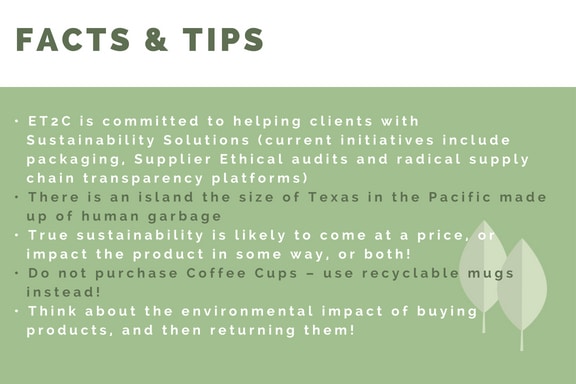BY: Simon Archer-Perkins – Director

Retail has and is evolving. The interaction between the consumer and the Brand has become closer. The consumer is now exposed to an array of multi-channel advertising, ‘likes’ and other targeted media advertising. It is therefore no longer good enough just to be selling a product at the right price. With all this choice, broadly the consumer now wants an in depth understanding of the Brand’s ethos – what they stand for – and how this is integrated into the product that they receive in the post the day after pressing ‘add to cart’ on the chosen company’s website.
Increasingly, one aspect of this new ‘under the hood’ perspective focuses on ‘Sustainability’ and ‘Environmental Footprint’. This appears to have been born out of the emergence of the Millennial as a consumer force the world over. This is an age group between 16-36 and it is estimated that there are 2.5 billion of them globally. Due to the widespread adoption of technology, they make purchase decisions that are more engaged and complex. There is an expectation that products can be ordered at a touch of a button, shipped (of course for free within domestic markets) direct to their home and if they do not really like the product, they can return (and again without actually paying for the return shipping). At the same time, they want to make sure that the products are manufactured in a sustainable way, are environmentally friendly (using recycled ocean plastic, or organic yarn, or packaged in natural sea-grass fibres) and still meet any functional or design needs.

There is nothing wrong with wanting sustainable products. There is nothing untoward with wanting a good environmental footprint. There is nothing incorrect with wanting Asian factory workers to be treated well by the factories who employ them. That is all commendable. In most people’s Utopia, sustainability and protection of the environment would be a given. There would be no waste, period. However, are these demands realistic?
Consumer Brands are, and have been scrambling, to promote sustainability and are increasingly providing full transparency across all their global factories whether wholly owned or third party. Pictures of the factories and the individuals who made the products are more and more commonly adorning the sustainability pages of a Brand’s website. Some companies are even moving to give consumers the choice at the point of purchase which country and factory they want to buy from. It is becoming an integral part of the decision-making process whether to buy a dress or some jeans from China or Sri Lanka. This all costs money, and some will argue money well spent.

There is one issue that is prevalent in a lot of the conversations we have had over the past year with retailers and Brands. For all their good intentions (and they are good), the notion of the ‘sustainable Consumer’ is in fact oxymoronic. It is a contradiction. The issue that is consistently raised is that the consumer does not want to pay any more for this level of sustainability. It is a ‘given’. A part of the price they have always paid for the product, and if it is not, well, they will move to put their money in another Brand’s coffers.
For a Brand to properly implement a sustainability strategy it must be an innate part of their core strategy. They need to live and breathe it and this needs to infiltrate down through their manufacturing partners to the very product make-up. There are therefore concessions to make that will and have to cost money. The recycled pulp shoebox will cost more than the traditional version, and it will not visually look as nice, and you will not be able to use the same print but it is more sustainable, as an example.

In order for the Brands to properly implement sustainability as a core strategy, the consumer must be willing to pay a little bit more. This is particularly true of emerging brands who do not have the margins or cash reserves of their established multinational competition. Key to this point is that the monies have to likewise filter down to the manufacturers and their sub-suppliers and in certain circumstances the salaries paid to the workers themselves. There is no point in requesting gold when you only are willing to pay for brass.
Sustainability starts with a decision by the consumer. They need to be prepared to pay more to ensure that it becomes an innate part of any Brand’s strategy and the investment is strategically harnessed in a way that empowers the supply chain to really innovate and deliver true sustainability.








